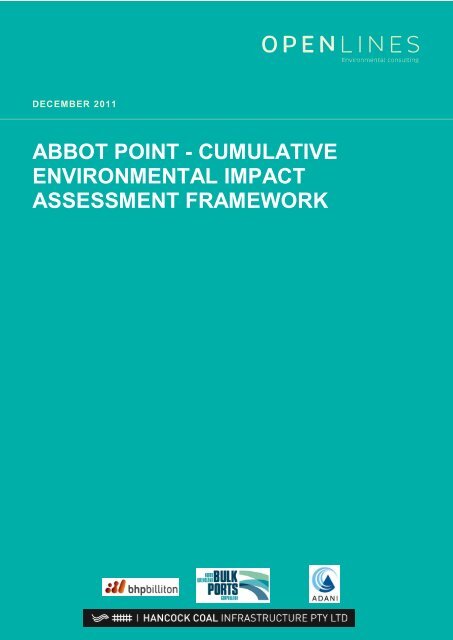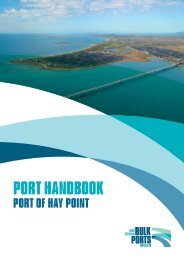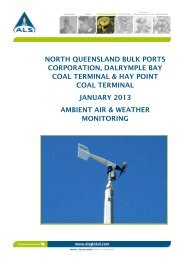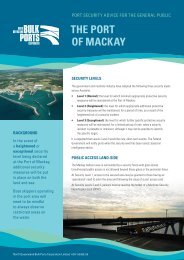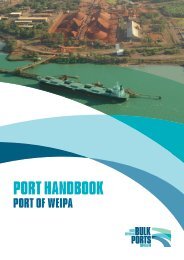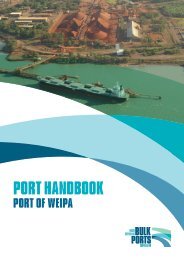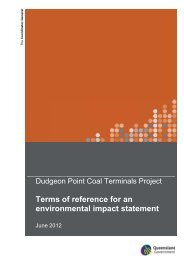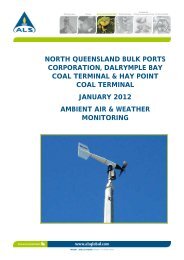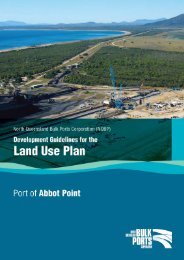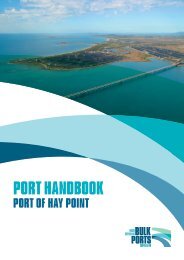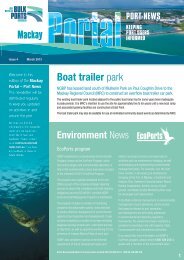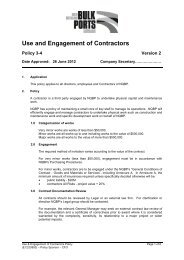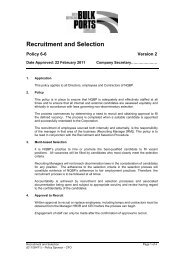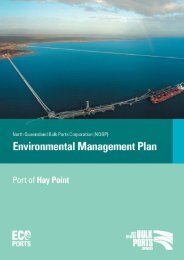abbot point - cumulative environmental impact assessment framework
abbot point - cumulative environmental impact assessment framework
abbot point - cumulative environmental impact assessment framework
Create successful ePaper yourself
Turn your PDF publications into a flip-book with our unique Google optimized e-Paper software.
DECEMBER 2011<br />
ABBOT POINT - CUMULATIVE<br />
ENVIRONMENTAL IMPACT<br />
ASSESSMENT FRAMEWORK
DOCUMENT TRACKING<br />
PREPARED BY: Peter Hemphill<br />
VERSION: 23/ 12/ 11<br />
DATE: December 2011<br />
COORDINATED APPROACH TO ENVIRONMENTAL ASSESSMENT AT<br />
ABBOT POINT<br />
Prepared for BHP Billiton , HCIPL, Adani, NQBP<br />
December 2011<br />
Open Lines Environmental Consulting<br />
openlines.com.au<br />
ABN 90 150 901 965<br />
The coordinated <strong>environmental</strong> <strong>assessment</strong> at Abbot Point is a joint initiative<br />
between BHP Billiton, Hancock Coal Infrastructure Pty Ltd, North Queensland<br />
Bulk Ports Corporation and Adani.<br />
ABBOT POINT CUMULATIVE ENVIRONMENTAL IMPACT ASSESSMENT<br />
DISCLAIMER<br />
This document may only be used for the purpose for which it was<br />
commissioned and in accordance w ith the contract between Open Lines<br />
Environmental Consulting and BHP Billiton.<br />
Open Lines Environmental Consulting accepts no liability or responsibility<br />
whatsoever for or in respect of any use of or reliance upon this report and its<br />
supporting material by any third party. Information provided is not<br />
intended to be a substitute for legal advice in relation to any matter.<br />
Unauthorised use of this report in any form is prohibited .<br />
1|
Contents<br />
ABBOT POINT CUMULATIVE ENVIRONMENTAL IMPACT ASSESSMENT<br />
1. INTRODUCTION ............................................................................................................................................................. 3<br />
1.1 Projects at Abbot Point .......................................................................................................................................... 4<br />
1.2 Environmental <strong>assessment</strong> requirements ............................................................................................................... 5<br />
2. PROPOSED APPROACH ............................................................................................................................................... 6<br />
2.1 Aims ..................................................................................................................................................................... 6<br />
2.2 Use of project-by-project <strong>assessment</strong>s................................................................................................................... 6<br />
2.3 Key measures ....................................................................................................................................................... 7<br />
3. CUMULATIVE IMPACT ASSESSMENT REPORT ........................................................................................................... 9<br />
3.1 Content of the <strong>cumulative</strong> <strong>impact</strong> <strong>assessment</strong> report .............................................................................................. 9<br />
3.2 Technical studies to inform <strong>cumulative</strong> <strong>impact</strong> <strong>assessment</strong> ................................................................................... 10<br />
2|
1. Introduction<br />
ABBOT POINT CUMULATIVE ENVIRONMENTAL IMPACT ASSESSMENT<br />
The Port of Abbot Point is one of three major coal export ports on the Queensland coast (see Figure 1). Abbot Point has been<br />
identified by the Queensland Government as critical to economic development in north and central Queensland. Land adjacent<br />
to the port has been designated as a State Development Area. The port is currently the subject of a number of development<br />
proposals with the main focus of these being the handling and export of coal. Table 1 sets out current known and anticipated<br />
proposals, including several that have commenced their respective Commonwealth and State <strong>assessment</strong> and approval<br />
processes. These proposals are being put forward by four key proponents – Adani, BHP Billiton, Hancock Coal and North<br />
Queensland Bulk Ports (NQBP).<br />
A well planned and timely <strong>environmental</strong> <strong>assessment</strong> processes is vital to:<br />
� underpin economic investment, State development and future job creation; and<br />
� protect the <strong>environmental</strong> values of Abbot Point, particularly within the context of the values of the Great Barrier Reef<br />
World Heritage Area (GBRWHA).<br />
In order that the projects can proceed through their respective <strong>assessment</strong>s in suitable timeframes , it is important that the<br />
necessary <strong>environmental</strong> information is available and that appropriate management measures are applied . To do this it is<br />
evident that a coordinated and combined approach to <strong>environmental</strong> <strong>impact</strong> <strong>assessment</strong> is required. The purpose of this report<br />
is to outline a coordinated approach to addressing the <strong>environmental</strong> <strong>assessment</strong> and approval requirements at Abbot Point<br />
under the Environm ent Protection and Biodiversity Conservation A ct 1999 (EPBC Act) .<br />
The approach recognises that, while individual project <strong>assessment</strong>s are already underway, each of these project level<br />
<strong>assessment</strong>s will benefit from a collective set of information and management responses to assist the Commonwealth<br />
Government in making informed decisions on individual projects at Abbot Point. The information gathered will also be able to<br />
be used to inform State approval processes, contribute information to other Great Barrier Reef World Heritage Area <strong>assessment</strong>s<br />
that may be undertaken in parallel or into the future. The information will provide the basis for ongoing coordinated<br />
management and monitoring <strong>framework</strong>s.<br />
Figure 1: major coal export ports in Queensland<br />
3|
1.1 PROJECTS AT ABBOT POINT<br />
ABBOT POINT CUMULATIVE ENVIRONMENTAL IMPACT ASSESSMENT<br />
The existing and proposed projects at Abbot Point are outlined in the table below and illustrated in Figure2.<br />
Project name Proponent Description EPBC status<br />
T0 & associated rail Adani Additional expansion relating to T1 of approximately 35mtpa Referred<br />
T1 (existing operation) Adani Existing 50mtpa coal export terminal and associated rail -<br />
T2 & associated rail<br />
T3 & associated rail<br />
T4-T9 & Multi User<br />
Infrastructure Corridor<br />
BHP<br />
Billiton<br />
Hancock<br />
Coal<br />
60mtpa expansion<br />
60mtpa expansion<br />
TBC Indicative only (6 terminals up to 240mtpa)<br />
4|<br />
Separate referrals for p ort<br />
and rail<br />
Separate referrals for p ort<br />
and rail<br />
T0 / T2 / T3 dred ging NQBP Com bined dred ging proposals Referred<br />
Multi Cargo Facility (MCF) NQBP<br />
Further coal export capacity and capacity for other large scale<br />
industries<br />
Figure 2: overview of current and proposed projects at Abbot Point<br />
Referral expected mid<br />
2012<br />
Decision Pending
1.2 ENVIRONMENTAL ASSESSMENT REQUIREMENTS<br />
The need for a coordinated <strong>assessment</strong> stems from the need to:<br />
ABBOT POINT CUMULATIVE ENVIRONMENTAL IMPACT ASSESSMENT<br />
� determine the scale of <strong>cumulative</strong> <strong>impact</strong>s on Matters of National Environmental Significance (MNES) from existing and<br />
planned projects in the Abbot Point area;<br />
� identify where modifications to individual projects may be required, and to establish performance requ irements for<br />
future development;<br />
� identify appropriate mitigation and management measures that can be undertaken in a combined manner;<br />
� provide a platform for ongoing collective monitoring and management responses; and<br />
� address concerns raised by UNESCO about development near to the Great Barrier Reef in a coordinated manner.<br />
The four proponents at Abbot Point are committed to delivering positive environm ental outcomes for MNES and see<br />
coordination of the <strong>environmental</strong> <strong>assessment</strong>s as a best practice approach to delivering these outcomes.<br />
The potential activities that may lead to <strong>cumulative</strong> <strong>impact</strong>s on MNES are illustrated in Figure 3.<br />
Figure 3: indicative representation of activities that may lead to <strong>cumulative</strong> <strong>impact</strong>s and the relevant MNES<br />
5|
ABBOT POINT CUMULATIVE ENVIRONMENTAL IMPACT ASSESSMENT<br />
The Commonwealth Government Department of Sustainability, Environment, Water, Population and Communities (SEWPaC)<br />
has stated that it is seeking a „strategic‟ approach to the handling of the individual <strong>environmental</strong> <strong>assessment</strong>s at Abbot Point.<br />
Benefits of a more strategic approach would include the ability to understand the potential <strong>cumulative</strong> <strong>impact</strong>s, as well as to<br />
develop common or consolidated measures between proponents to avoid, mitigate and offset <strong>impact</strong>s.<br />
The proponents at Abbot Point are supportive of an approach that achieves these outcomes and notes the difficulty of<br />
commencing a statutory strategic <strong>environmental</strong> <strong>assessment</strong> when a number of the proposed projects are well underway with<br />
existing approval processes that have been designed to meet strict timeframes. In proposing this coordinated approach to<br />
<strong>environmental</strong> <strong>assessment</strong> at Abbot Point, the proponents have sought to take advantage of the benefits of a strategic<br />
<strong>assessment</strong>, while avoiding difficulties and delays that may arise due to:<br />
� the complexity of the current state of project <strong>assessment</strong>s and the uncertainty associated with establishing a strategic<br />
<strong>assessment</strong> agreement at this <strong>point</strong>;<br />
� the lack of legislative timeframes within the strategic <strong>assessment</strong> process and the experience to date which suggests<br />
strategic <strong>assessment</strong>s take a minimum of two years to complete; and<br />
� the time that would be required to initiate such an approach.<br />
Accordingly, this report proposes a voluntary, proponent led approach that would provide the Commonwealth Environment<br />
Minister with the same <strong>cumulative</strong> <strong>impact</strong> information necessary to make informed decisions over time. The information that<br />
would be provided through this approach will demonstrate the rigour of the <strong>environmental</strong> <strong>assessment</strong>s undertaken and the<br />
totality of <strong>impact</strong>s occurring at the Port of Abbot Point.<br />
2. Proposed approach<br />
This section outlines the proposed approach for coordinating the <strong>environmental</strong> <strong>assessment</strong>s at Abbot Point. The proposed<br />
scope for this work includes the known proposals within the Abbot Point State Development Area and Strategic Port Land, and<br />
their related offshore components.<br />
2.1 AIMS<br />
The aims of the proposed approach are to:<br />
1. understand the <strong>cumulative</strong> <strong>impact</strong>s of known projects operating and proposed at Abbot Point;<br />
2. determine individual and joint management and mitigation actions required to avoid, minimise and manage <strong>impact</strong>s;<br />
3. develop a <strong>framework</strong> for joint mitigation of <strong>impact</strong>s and, if necessary, offsets to address residual <strong>impact</strong>s such that there<br />
will be a “maintain or improve” outcome for MNES;<br />
4. allow timely <strong>assessment</strong> and approval processes to continue for the individual proponents; and<br />
5. use project-by-project <strong>assessment</strong> mechanisms to deliver these outcomes.<br />
2.2 USE OF PROJECT-BY-PROJECT ASSESSMENTS<br />
Coordination of project-by-project <strong>assessment</strong>s, being considered through Part 9 of the EPBC Act, provides the opportunity to<br />
consider the <strong>cumulative</strong> <strong>impact</strong>s at Abbot Point and deliver strategic outcomes for MNES. Figure 4 illustrates a potential<br />
<strong>framework</strong> for such an approach.<br />
This approach is supported by:<br />
1. Coordination between proponents and regulators on all of the key issues.<br />
2. Preparation of a platform of information to understand the potential <strong>cumulative</strong> <strong>impact</strong>s on MNES (e.g. potential<br />
<strong>impact</strong>s on migratory shorebirds from <strong>impact</strong>s relating to dust, light, noise and construction).<br />
3. Delivery of positive outcomes for MNES through coordinated:<br />
a. avoidance of <strong>impact</strong>s at Abbot Point;<br />
b. mitigation of <strong>impact</strong>s (e.g. through a whole of port <strong>environmental</strong> monitoring and management program );<br />
c. management and monitoring measures to maintain and improve the environment; and<br />
d. offsets (e.g. coordinated offsets for the <strong>cumulative</strong> <strong>impact</strong>s at Abbot Point).<br />
4. Development of a <strong>cumulative</strong> <strong>impact</strong> <strong>assessment</strong> report for Abbot Point (discussed further in Section 3) that will be<br />
included by proponents in their individual <strong>assessment</strong> documentation.<br />
5. Use of port wide <strong>environmental</strong> controls (NQBP) and project-by-project legislative measures (e.g. approval<br />
conditions) to deliver the required outcomes.<br />
6|
ABBOT POINT CUMULATIVE ENVIRONMENTAL IMPACT ASSESSMENT<br />
This approach will provide the decision maker with the ability to understand the potential <strong>cumulative</strong> <strong>impact</strong>s at Abbot Point,<br />
how each project fits into that context, and the proposed avoidance, mitigation and offset measures that will deliver benefit s for<br />
MNES in a coordinated manner. Individual projects can then be considered for approval within this context.<br />
It is envisaged that the information gathered and the management standards and measures adopted will also provide a<br />
platform that future development at Abbot Point can also use in project specific <strong>assessment</strong>s. This will include the opportuni ty<br />
to participate in established joint monitoring and management <strong>framework</strong>s.<br />
2.3 KEY MEASURES<br />
In order to successfully deliver on a coordinated <strong>environmental</strong> <strong>assessment</strong>, it is essential that the following measures are put in<br />
place.<br />
� Commitment to the process from all parties.<br />
� Agreement on priorities and timeframes.<br />
� Agreement on a decision making process to ensure issues can be resolved and <strong>assessment</strong> processes kept moving.<br />
� The development and review of information to meet critical timeframes.<br />
� Peer review mechanisms built into the development of information to ensure robust and acceptable outcomes are<br />
delivered.<br />
� Development and implementation of an agreed approach to regulator liaison. This should include:<br />
o a proponent steering group and working group to which regulators would be invited to attend as observers when<br />
appropriate; and<br />
o engagement with regulators at key milestones in the process to ensure the <strong>cumulative</strong> <strong>assessment</strong> delivers the<br />
required information and outcomes. Key milestones include:<br />
� finalisation of the scopes of technical studies to inform the <strong>cumulative</strong> <strong>impact</strong> <strong>assessment</strong> report (see<br />
Section 3.2);<br />
� finalisation of the technical studies;<br />
� the draft structure of the <strong>cumulative</strong> <strong>impact</strong> <strong>assessment</strong> report;<br />
� the draft <strong>cumulative</strong> <strong>impact</strong> <strong>assessment</strong> report; and<br />
� the final <strong>cumulative</strong> <strong>impact</strong> <strong>assessment</strong> report.<br />
7|
Figure 4: outline of the proposed coordinated <strong>assessment</strong> approach<br />
ABBOT POINT CUMULATIVE ENVIRONMENTAL IMPACT ASSESSMENT<br />
8|
3. Cumulative <strong>impact</strong> <strong>assessment</strong> report<br />
ABBOT POINT CUMULATIVE ENVIRONMENTAL IMPACT ASSESSMENT<br />
Preparation of the <strong>cumulative</strong> <strong>impact</strong> <strong>assessment</strong> report will be a critical step both in synthesizing the overall <strong>assessment</strong> of<br />
<strong>impact</strong>s on MNES and communicating the outcomes of the process. It is this report that will provide regulators with a clear<br />
view about:<br />
� the MNES values of the area;<br />
� predicted <strong>cumulative</strong> <strong>impact</strong>s;<br />
� proposed avoidance, mitigation, management and offset measures; and<br />
� overall outcomes for MNES (e.g. World Heritage, threatened species and migratory species).<br />
The report will be informed by a number of technical studies designed to provide detailed analysis of key <strong>assessment</strong> issues<br />
(e.g. shipping, underwater noise, dredging <strong>impact</strong>s). The proposed technical studies are outlined in Section 3.2.<br />
3.1 CONTENT OF THE CUMULATIVE IMPACT ASSESSMENT REPORT<br />
The <strong>cumulative</strong> <strong>impact</strong> <strong>assessment</strong> report will incorporate the following information:<br />
INTRODUCTION<br />
� Context for the <strong>assessment</strong><br />
o Abbot Point as a State Development Area (including background to this decision)<br />
o Existing industrial port<br />
o Strategically located to provide export capacity from the northern Bowen Basin and Galilee Basin<br />
� Objectives of the <strong>cumulative</strong> <strong>assessment</strong><br />
� Parties (Adani, BH B Billiton, GVK/ Hancock Coal, NQBP)<br />
� Projects<br />
o T0 & associated rail<br />
o T1 (existing operation)<br />
o T2 & associated rail<br />
o T3 & associated rail<br />
o T4-T9 & Multi User Infrastructure Corridor<br />
o T0 / T2 / T3 dredging<br />
o Multi Cargo Facility (MCF)<br />
SCOPE<br />
� Detail about the various projects<br />
� Scope of <strong>cumulative</strong> <strong>impact</strong> <strong>assessment</strong><br />
o clarity about the spatial and temporal nature of the projects<br />
o the scope of <strong>cumulative</strong> <strong>impact</strong>s being assessed<br />
� Scope of the technical studies that are informing th e <strong>cumulative</strong> <strong>impact</strong> <strong>assessment</strong><br />
APPROACH<br />
� Outline of the approach to the <strong>assessment</strong> process<br />
o overall coordinated <strong>assessment</strong> process<br />
o approach to the studies<br />
o coordination between proponents, State Government and Commonwealth Government<br />
o links to individual project approvals<br />
STUDIES<br />
� Outline the results of each of the studies in terms of predicted <strong>impact</strong>s and potential mitigation measures<br />
� Study reports to be appended<br />
MNES IMPACT ASSESSMENT<br />
� MNES relevant to the <strong>assessment</strong> including the process used to determine these<br />
� For each relevant MNES (e.g. GBRWHA, listed threatened species, listed migratory species)<br />
o general background information<br />
o details of information sources<br />
9|
o known or potential values for each MNES<br />
o potential direct and indirect <strong>cumulative</strong> <strong>impact</strong>s<br />
o avoidance, mitigation and management measures proposed in relation to each MNES<br />
o residual <strong>impact</strong>s and proposed offsets<br />
o overall outcomes for each MNES<br />
CONCLUSION<br />
ABBOT POINT CUMULATIVE ENVIRONMENTAL IMPACT ASSESSMENT<br />
� Summary of the outcomes of the <strong>cumulative</strong> <strong>impact</strong> <strong>assessment</strong><br />
o how requirements for avoiding, mitigating and managing <strong>impact</strong>s will be built into individual projects<br />
o outline of joint monitoring <strong>framework</strong><br />
o discussion of joint offsets program<br />
3.2 TECHNICAL STUDIES TO INFORM CUMULATIVE IMPACT ASSESSMENT<br />
The table below outlines the information and technical studies that will be used to inform the <strong>cumulative</strong> <strong>impact</strong><br />
<strong>assessment</strong>.<br />
Activity Potential <strong>cumulative</strong> <strong>impact</strong>s Scope of <strong>cumulative</strong> <strong>assessment</strong> w ork<br />
Dredging and Spoil Disposal Seabed / benthic loss 1. Com bined footprint, sediment plumes and other<br />
Light penetration <strong>impact</strong>s on Seagrass<br />
Turbidity and sedimentation <strong>impact</strong>s on seagrass,<br />
corals other sensitive marine environments<br />
Marine mam mals and reptile injury, loss or habitat<br />
alienation<br />
Land and ocean disposal <strong>impact</strong>s (eg w etland,<br />
benthic sm othering)<br />
<strong>impact</strong> <strong>assessment</strong> for MCF/ T0/ T2/ T3.<br />
2. Addition of exiting information generated for<br />
MCF d redging and land reclamation.<br />
Options disposal stu dy for T0, T2 and T3.<br />
Trestle/ MCF construction Underw ater noise Piling for T0/ T2/ T3, sheet piling and other piling for<br />
Terminal Construction<br />
(stockyards, sediment ponds,<br />
w ater storage, roads and rail<br />
loops)<br />
MCF.<br />
Temporal and spatial effects of overlapping activities<br />
and/ or effects of consecutive activities.<br />
Mitigation measures relevant for different scenarios<br />
Seabed/ Habitat loss Com bined calculation of <strong>impact</strong>s.<br />
Habitat loss and modification<br />
Terminal Operation Operational noise<br />
1. Com bined direct loss to migratory bird habitats,<br />
threatened species and TEC (SEVT).<br />
2. Habitat modification from light, noise and w ater<br />
quality degradation on listed migratory birds etc.<br />
3. Include <strong>impact</strong>s of T4-T9 on w etland.<br />
Groundw ater changes 1. Interpretation of existing (limited) data to<br />
determine <strong>impact</strong>s on w etland<br />
2. Development of a groundw ater monitoring plan<br />
3. Development of contingencies in the event that<br />
adverse <strong>impact</strong>s occur<br />
Calculation of noise envelope from T0, T1, T2, T3, T4-<br />
T9, MCF and existing rail on w etland (listed migratory<br />
birds) and nearby beaches (turtles).<br />
Coastal process changes Build on MCF EIS to include <strong>impact</strong>s of T0-T3 jetties<br />
and dredging.<br />
Hydrology and w ater quality changes Include effect of sedimentation pond overflow s in 1 in<br />
10|
ABBOT POINT CUMULATIVE ENVIRONMENTAL IMPACT ASSESSMENT<br />
Activity Potential <strong>cumulative</strong> <strong>impact</strong>s Scope of <strong>cumulative</strong> <strong>assessment</strong> w ork<br />
10 year event<br />
Include effects of reduction in inflow to w etland.<br />
Visual aesthetics Expert view and rep resentation on w hether landscape<br />
at Abbot Point is materially changed. Examine against<br />
existing landscape character and values; human access<br />
and appreciation; WHA values of u niversal<br />
outstanding value as demonstrated in other parts of<br />
Lighting effects Model light shed from T0-T9 and MCF on w etland,<br />
GBR.<br />
beaches and marine environment. Assess <strong>impact</strong>s to<br />
birds, tu rtles other listed w ildlife.<br />
Dust Model d ust deposition from terminal operation on<br />
listed threatened and migratory species.<br />
Shipping Transit <strong>impact</strong>s Based on projected shipping num bers for Abbot Point<br />
examine the likely risk of:<br />
� Groundings<br />
� Vessel collisions<br />
� Oil spill<br />
� Marine mam mal / reptile strike<br />
Consider implications of:<br />
� GH G/ climate change<br />
Anchorage im pacts Examine <strong>impact</strong>s of:<br />
Regulatory regime<br />
� Visual aesthetics against WHA values<br />
� Waste (ship generated)<br />
� Noise<br />
� Visual aesthetics<br />
� Fishing amenity<br />
� Introduced marine pests<br />
� Turbidity/ seabed / benthic disturbance.<br />
� New anchorages (need, triggers, selection<br />
criteria)<br />
Examine existing regulatory regime; identify gaps and<br />
risk. Develop mitigation measures to address risks.<br />
Fishing Access restrictions Examine the implications for com mercial and<br />
recreational fishers during construction and operation.<br />
Joint Offsets Program Compensate for residual <strong>impact</strong>s Develop a coordinated offset program involving all<br />
port operators at Abbot Point. Needs to:<br />
� address all residual <strong>impact</strong>s<br />
� provide a net gain<br />
� enable proponents to contribute p roportionally<br />
� scalability<br />
� focus on Abbot Point, nearby locations and<br />
MN ES<br />
11|


